

IF YOU ONLY GET ONE CHANCE to make a first impression, as the saying goes, then these small plates are on the right track. From the classic Fennel Breadsticks, which have been a complimentary offering at Chico since the mid-1970s, to the deconstructed Ahi Wonton with Avocado Slaw and Citrus Chili Aioli, this selection of appetizers captures the diverse flavors of a unique American restaurant. The trout in these recipes is straight from the waters of Paradise Valley, the local chèvre is smoked out back, and the bison is native to these parts. It’s the perfect way to begin a meal.
Note: Recipes denoted by  are Chico “Classics.”
are Chico “Classics.”
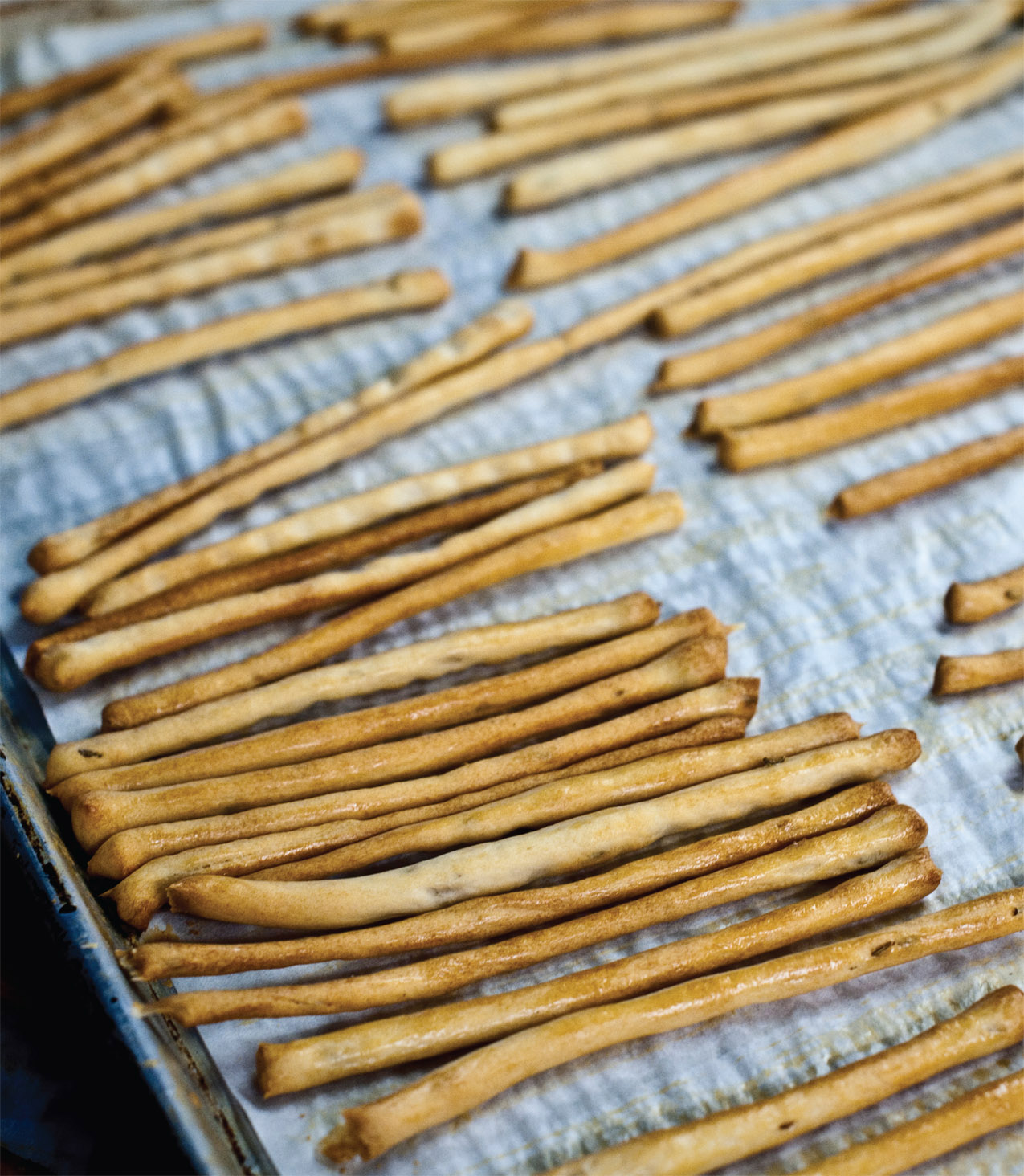

These light and crispy breadsticks have been served at the dinner table since 1973. A recipe from Chef Larry Edwards, over the years it has been requested most by guests. The secret to making these at home is to not overmix the dough and to gently roll out the pieces before baking.
MAKES 4 DOZEN BREADSTICKS
Ingredients
½ cup beer, room temperature
½ cup warm water (approximately 110°F)
1½ teaspoons instant yeast
3 cups bread flour
¾ teaspoon salt
½ cup extra-virgin olive oil
3 tablespoons dried fennel seeds
1 egg
½ cup heavy whipping cream
Instructions
Preheat oven to 425°F. Prepare a baking sheet by covering it with parchment paper and coating with cooking spray.
Mix beer, warm water, and yeast; let sit until it bubbles, about 10 minutes. Add flour, salt, olive oil, and fennel seeds and mix in the bowl of an electric mixer fitted with a dough hook or knead by hand until smooth. Do not overmix or the dough will become tough. The dough should be slightly sticky, but still easy to form into a large ball. If it sticks to your fingers, add a little more flour. Place dough in a well-oiled mixing bowl and let rise in a warm place until it doubles in size, approximately 1 hour. While dough is rising, whisk the egg and heavy whipping cream together and set aside.
Once the dough has risen, gently punch it down and place onto a work surface coated lightly with cooking spray to prevent sticking. With a rolling pin, flatten dough evenly until it is ¼ inch thick. Cut across the width of the dough, making strips that are approximately 1 inch wide (a pizza cutter makes long, even strips). Using a light touch, roll each piece of dough by hand into rounded strips. Each strip will be quite long; cut as necessary to form 6- to 8-inch pieces. Place breadsticks on the baking sheet. Using a pastry brush, coat the breadsticks with the egg wash.
Bake for 15 to 20 minutes, rotating the baking sheet halfway through cooking, until breadsticks are a light golden brown. Serve with whipped butter.
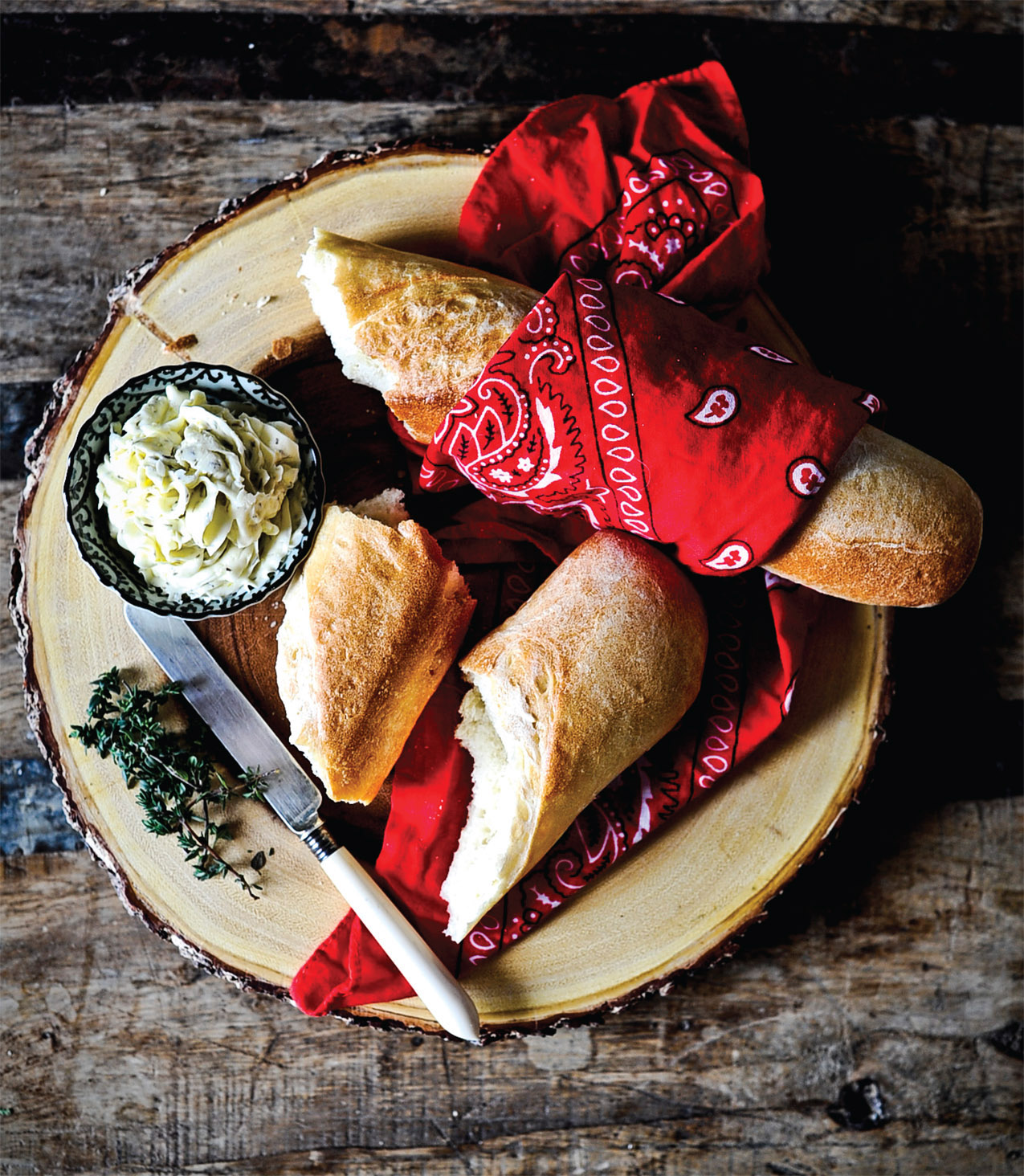

This simple French bread is baked daily in the Chico kitchen and served at every table in the dining room. In the restaurant we prepare it in baguette form, long and thin, for uniformity. But at home you can be more creative—try braiding one loaf or twisting another to give this staple a decorative flair.
MAKES 2 LOAVES
Ingredients
8 cups bread flour (a high-gluten flour)
1 tablespoon salt
3 cups warm water (approximately 110°F)
2 teaspoons instant yeast
½ cup cornmeal
1 egg white
½ teaspoon salt
Instructions
Place flour, salt, water, and yeast into the bowl of an electric mixer fitted with a dough hook. If you are mixing the bread by hand, be sure to use swift, strong strokes to prevent overmixing. Combine ingredients thoroughly, adding more flour as necessary to achieve a soft, smooth texture. Knead for 10 minutes.
Move dough to a clean bowl (do not coat in oil) and cover with plastic wrap. Let rise until double in size, about 1 to 1½ hours. Gently punch down dough and divide into two equal pieces. Let rest for 5 minutes. Flatten each piece into an oval and form into desired shape. Be careful not to knead or handle it too much at this stage, because it will become tough. Place on a baking sheet sprinkled with cornmeal or into a French loaf bread pan. Cover and let rise until the loaves almost double in size, about 30 minutes.
Preheat oven to 425°F. Combine the egg white and salt; brush loaves generously with the mixture. Slash loaves diagonally with a sharp serrated knife in three or four places. Bake for 15 minutes, then reduce heat to 375°F. Bake 30 minutes more, until bread is golden and crusty.
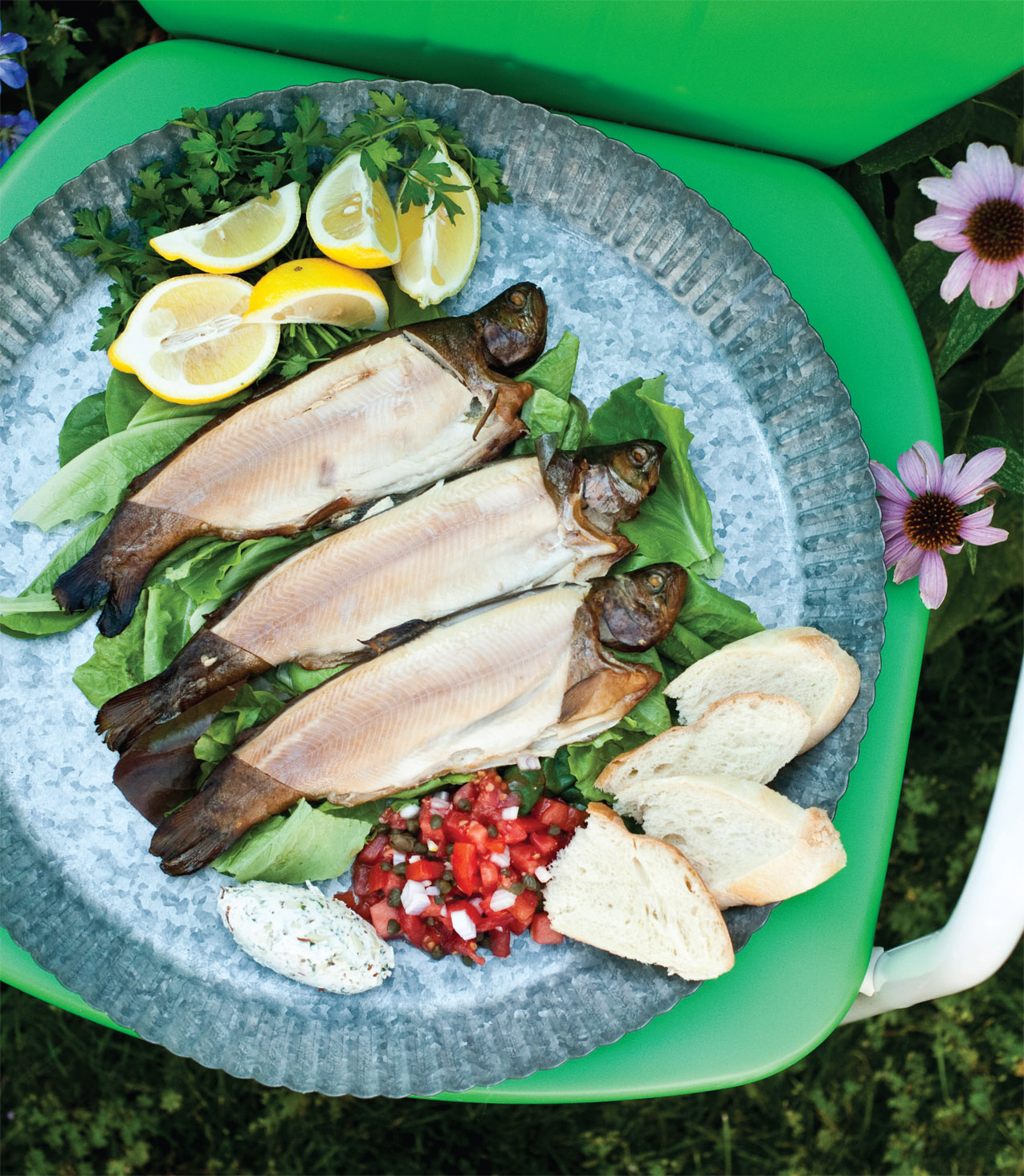

The cooks at Chico rely on Paradise Valley’s Trout Culture team to raise organic, local rainbow trout that is rich in flavor for this classic appetizer. Prepared daily, the fish is marinated in a curry, salt, and brown sugar brine with the skin intact, then slow-smoked over alder wood until it reaches firm, flaky perfection. The process takes two hours, but is well worth the effort to develop this flavor. For home preparation, it’s simple to convert a barbecue grill into a smoker using soaked wood chips and a low temperature. Of course, you could also purchase smoked trout or substitute smoked salmon from a local grocer, but where’s the fun in that?
SERVES 4–6
Ingredients
FOR THE TOASTED ALMOND AND DILL CREAM CHEESE:
Zest and juice of ½ lemon
2 tablespoons sliced toasted almonds
¼ cup sour cream
8 ounces cream cheese, room temperature
1 teaspoon minced fresh dill
½ teaspoon salt
FOR THE TOMATO-CAPER RELISH:
3 large Roma tomatoes, seeds removed, diced
1 small red onion, diced
¼ cup capers
¼ cup chopped fresh chives
2 tablespoons apple cider vinegar
2 tablespoons minced fresh parsley
Salt and freshly ground black pepper to taste
FOR THE TROUT AND BREAD:
4–5 ounces boneless Smoked Trout (recipe page 195).
1 loaf French bread or Chico Heirloom Bread (recipe page 43)
Instructions
TO PREPARE THE TOASTED ALMOND AND DILL CREAM CHEESE:
Thoroughly combine all ingredients together by hand or in a mixer until easy to spread. Chill until ready to serve.
TO PREPARE THE TOMATO-CAPER RELISH:
Mix all ingredients together. Chill until ready to serve.
TO SERVE:
Display the trout in one piece on a platter, with the cream cheese spread and the relish on the side with sliced fresh bread.

Satisfyingly smoky, salty, and buttery, this is a simple appetizer that can easily be prepared in advance for serving at a dinner party.
MAKES ABOUT 14 PIECES
Ingredients
2 tablespoons finely diced shallot
3 tablespoons finely diced celery
¼ cup finely diced leeks
1 cup canola oil, divided
1½ pounds Yukon potatoes
1 tablespoon unsalted butter
⅓ cup heavy cream
2 teaspoons kosher salt
3 large eggs, divided
4 ounces Smoked Trout (recipe page 195)
1 cup all-purpose flour
1 cup panko bread crumbs
Instructions
Sweat shallots, celery, and leeks in a pan generously coated with canola oil. Meanwhile, peel and dice Yukons, then add to a large pot of water and boil until soft. Drain water from potatoes and use a fork or masher to mash the potatoes. Add butter, cream, shallots, celery, leeks, and salt, mashing and mixing until well combined. Place mixture in the refrigerator to cool for approximately 30 minutes to 1 hour.
Once the potatoes have cooled, mix in one egg and the smoked trout. Portion into 2-ounce cakes and cool in the freezer until stiff, at least 1 hour.
Set up a three-stage breading station: flour, egg wash, and panko. Bread the cakes with flour, then egg wash, and finally crust with panko. In a skillet, heat remaining canola oil (it should be about 1 inch deep) on medium-high. Test readiness by dropping a little panko in the pan; when it quickly fries to a golden color, the oil is the perfect temperature. Carefully place croquettes in the pan; avoid crowding the pieces in order to keep the oil temperature consistent. Fry on both sides until golden brown.
Serve on a bed of fresh garden greens with your dressing of choice, such as the Orange-Ginger Vinaigrette (recipe page 84). Other complimentary sauces include the Roasted Tomato Hollandaise (recipe page 29) or the Smoked Corn-Quinoa-Black Bean Salsa (recipe page 127).

In the 1970s and 1980s artichokes were considered exotic and were not commonly found in grocery stores. During this period, a chilled artichoke was a complimentary starter during dinner in Chico’s historic dining room. Served with a touch of curried mayo, it is a simple, but memorable, amuse bouche.
SERVES 4–8
Ingredients
FOR THE ARTICHOKES:
4 large artichokes
FOR THE CURRY AIOLI:
1 cup mayonnaise
1 tablespoon mild yellow curry
Instructions
TO PREPARE THE ARTICHOKES:
Cut stems if desired. (The stems taste as good as the heart, so you can also leave them.) Trim the thorny tips of the outside leaves with scissors, and with a serrated knife slice off the top. Place artichokes in a steaming basket over 1 to 2 inches of boiling water. Cook covered until tender, about 25 to 35 minutes for medium artichokes and up to 45 minutes for large artichokes. Test for tender readiness by plucking a leaf from the middle of the vegetable; if it pulls out easily, artichokes are done. Chill for at least 1 hour in the refrigerator.
TO PREPARE THE CURRY AIOLI:
Combine mayonnaise and curry, then whisk until thoroughly combined.
TO SERVE:
Cut chilled artichokes into quarters and scoop out the fuzzy portion at the center of the artichoke, but be sure not to cut any of the treasured heart, the best part. Lay sliced-side down on a plate. Spoon the Curry Aioli into a small side dish or ramekin for dipping and serve.

There are about forty species of huckleberries, all native to North America. In Montana the black huckleberry, dark purple in color, is the most widespread. Huckleberries are difficult to come by, even in Montana; appropriate substitutes in this dish are lingonberry, currant, or blackberry preserves. Regardless of which fruit you choose, what is essential for this starter is that the berry sauce balances the creamy hollandaise with a precise sweetness and tartness. Timing is also key; the baked Brie and sauces should be served immediately.
SERVES 4–6
Ingredients
FOR THE HUCKLEBERRY COULIS:
1 cup huckleberry preserves
Zest of 1 orange
½ cup cranberry juice
FOR THE BAKED BRIE:
8 ounces Brie cheese
4 (5 × 5-inch) premade puff pastry sheets (available at most grocery stores in the frozen dessert section)
3 eggs
¼ cup half-and-half
FOR SERVING:
1 loaf of French bread or Chico Heirloom Bread (recipe page 43)
1 cup Hollandaise Sauce (recipe page 188)
Instructions
TO PREPARE THE HUCKLEBERRY COULIS:
Place all ingredients into a blender or food processor and puree until smooth. Set aside.
TO PREPARE THE BAKED BRIE:
Preheat oven to 450°F. Line a baking sheet with parchment paper.
Trim the rind of the Brie so that only the soft, creamy portion remains. For a shared appetizer use the whole piece, but for individual mini-Bries, cut cheese into four 2-ounce squares. Gently wrap the pastry around the cheese as if you were wrapping a present; with your fingers crease the folds of the pastry to smooth and secure the dough.
Beat the eggs and half-and-half until mixed thoroughly for an egg wash. (This will prevent the puff pastry from burning in the oven.) Dip each pastry-wrapped Brie in the egg wash and place on the baking sheet. Bake until golden brown, about 15 to 20 minutes. The cheese should be melted in the center of the pastry. Check for doneness by inserting a toothpick into the center of the pastry; if the toothpick comes out clean, the Brie is done.
Cut bread diagonally into 1-inch slices, cover, and reserve until ready to serve.
TO SERVE:
Pour the hollandaise sauce onto an oversize platter or four individual serving plates, covering the surfaces completely. Next, drizzle huckleberry coulis in parallel lines to create decorative stripes over the hollandaise sauce. Place baked Brie squares on top of sauce. Serve the sliced bread on another plate or around the edge of the serving dish.
Wild mushrooms are a seasonal delicacy that brings the local foragers to the back door of the restaurant kitchen when they have a big crop. Springtime morels can draw $30 per pound, and autumn chanterelles are coveted for their nutty flavor. This recipe marries earthy wild mushroom tones with the wood-smoked tanginess of warm, creamy chèvre, a combination that is reminiscent of the habitat where these wild fungi are often found. The recipe calls for eight ounces of cheese, but don’t be afraid to use as much chèvre as you would like.
SERVES 8
Ingredients
¼ cup diced shallot
1 tablespoon olive oil
4 cloves garlic, diced
3 cups sliced wild mushrooms
1 cup white wine
1 tablespoon unsalted butter
2 tablespoons chopped fresh parsley, divided
Salt and freshly ground black pepper to taste
Crostini (recipe page 187)
8 ounces Smoked Chèvre (recipe page 195)
Instructions
In a large skillet, sweat shallots and garlic in a little olive oil over medium heat. Add mushrooms and continue to cook until softened. Once the shallots begin to caramelize, deglaze the pan with wine, stirring the mixture. Simmer until wine has reduced by half. Turn off heat, then add butter and 1 tablespoon parsley. Stir until butter has melted into the wine and thickened the sauce. Salt and pepper to taste.
Spoon mushroom mixture onto crostinis. Crumble smoked chèvre on top and garnish with remaining parsley.
This can be served as a light appetizer for a small group or split as an entree for two. The creamy curry and the sweet crunch of the salsa is a flavorful marriage with large buttery scallops seared to perfection.
SERVES 4–6
Ingredients
FOR THE MOROCCAN SALSA:
1 cup dried apricots, julienned
½ red onion, small diced
4 green onions, sliced thin
1 red pepper, small diced
1 cup black olives, sliced thin
FOR THE CURRY SAUCE:
1 tablespoon sesame oil
3 shallots, minced
2 tablespoons green curry paste
1 cup white wine
¼ cup lime juice
4 cups unsweetened coconut milk
1 cup cream of coconut (such as Coco Lopez brand)
FOR THE SCALLOPS:
12 large sea scallops (u/10)
1 tablespoon unsalted butter
Instructions
TO MAKE THE MOROCCAN SALSA:
Combine all ingredients in a bowl and mix thoroughly. Chill until ready to serve.
TO MAKE THE CURRY SAUCE:
In a saucepan combine the oil, shallots, and curry paste and cook over medium heat until the curry paste starts to brown. Deglaze with the wine and lime juice, then cook until reduced by half. Add coconut milk and cream of coconut and reduce by half again. Store in a covered container until ready for use.
TO COOK THE SCALLOPS:
Rinse scallops and pat dry with a paper towel. In a cast-iron or stainless steel skillet, melt butter over medium-high heat and evenly coat the pan. Set scallops into the super-hot pan (test with a few flecks of water that should sizzle upon contact) about 1 inch apart; you may need to cook in two batches. Cook for 2 minutes until scallops are golden brown and easily release with a spatula. Flip each scallop and cook for another 2 minutes. Remove scallops from the pan and set on a warm plate.
TO SERVE:
Ladle curry sauce onto a large platter, then spoon twelve separate mounds of Moroccan salsa on top of the sauce. Place one scallop on each mound for an elegant share appetizer.
This classic Chico recipe was developed by former chef Morgan Milton to create a balance between the earthy sweetness of corn and barbecue sauce and the hearty bison flavors. Relying on Montana-sourced bison and local microbrew Moose Drool from Bozeman Brewing Co., along with fresh corn and a toothsome house-made pasta, this multistep dish is worth the effort. To cut down on kitchen time, prepare the short ribs and barbecue sauce one day in advance.
SERVES 6 (MAKES ABOUT 25 RAVIOLIS)
Ingredients
FOR THE RAVIOLI DOUGH:
2 cups all-purpose flour
¼ teaspoon kosher salt
2 large eggs plus
2 egg yolks, beaten
FOR THE RAVIOLI FILLING:
2 pounds bison short ribs
2 tablespoons vegetable oil
2 cans Coca-Cola
Moose Drool BBQ Sauce (recipe page 189)
FOR THE SWEET CORN CREAM SAUCE:
2 cups sweet corn kernels
½ yellow onion, small diced
1 tablespoon vegetable oil
1 tablespoon apple cider vinegar
Salt and freshly ground black pepper to taste
1½ cups heavy cream
FOR THE CHILI OIL, FRIED CARROTS, AND GREEN ONIONS GARNISH:
1½ cups vegetable oil, divided (1 cup for chili oil, ½ cup for fried carrots)
1 tablespoon red pepper flakes
½ tablespoon cayenne pepper
1 large carrot
2 green onions

Instructions
TO MAKE THE RAVIOLI DOUGH:
Place flour and salt into a large bowl, forming a well in the center. Pour the beaten eggs into the well of flour and mix with a wooden spoon until combined into a shaggy dough. Turn dough onto a lightly floured surface and knead for approximately 10 minutes until it forms a smooth ball. Divide dough into four pieces. Flatten each into a 1-inch-thick disk and wrap individually in plastic wrap; let rest for 1 to 3 hours at room temperature.
Using a rolling pin (on a lightly floured surface) or a pasta machine, roll each piece of dough until it is as thin as possible, not quite paper thin (for a pasta machine, it would be at a setting of 3 or less). When each sheet is complete, stack with a light dusting of flour as you begin to assemble the raviolis.
TO PREPARE THE RAVIOLI FILLING:
Preheat oven to 325°F. Heat a large cast-iron skillet over high heat, letting the pan get very hot. Season the meat with salt and pepper. Add enough vegetable oil to coat the bottom of the pan, then sear the ribs on all four sides. Place seared ribs into a dutch oven or braising pan. Pour Coca-Cola over ribs, return to the stove, and bring to a boil. Cover braising pan and place in oven. Braise ribs for 2½ hours, or until tender.
Remove ribs from pan and strain the liquid through a fine-mesh strainer into a medium-size pot. Heat bison pan juices on the stove over medium-high heat until reduced by half; set aside. When the meat has cooled enough to work with, remove the bones along with any fat or sinew. Pull the meat into “shreds” with a fork or your fingers; there should be no large pieces, just even shreds. Add reduced liquid to shredded meat, than add a generous amount of Moose Drool BBQ sauce so the meat is well coated, mixing with a fork. Let cool and set aside. This mixture can be made up to 3 days in advance of service.
TO ASSEMBLE THE RAVIOLI:
Lay one sheet of pasta onto a flat work surface; keep the unused piece covered to prevent it from drying out. Using a tablespoon, mound the ravioli filling in a row down the pasta sheet, leaving 1 inch of space between each spoonful. Scoop approximately twenty-four spoonfuls onto dough. Lay the second sheet of dough over the top of the filling. With your fingers, seal the filling into the dough. Run a pizza cutter down the length of the dough and then across each row to cut squares, being careful not to cut too close to the filling to prevent raviolis from bursting when they are cooked. Crimp the edges of each square to seal. Repeat this process with the remaining two pieces of pasta. Cook immediately, refrigerate in a covered container for same- or next-day use, or freeze for up to 1 month.
TO COOK THE RAVIOLI:
Bring a large pot of water to a boil and add 1 teaspoon vegetable oil per quart of water and salt if desired. Add raviolis to boiling water; do not stir. Return water to a boil and cook 5 to 7 minutes, until texture of the pasta is to your liking; remove with a slotted spoon or pour into a strainer in the sink.
TO MAKE THE SWEET CORN CREAM SAUCE:
In a skillet on high heat, add corn, onions, oil, vinegar, salt, and pepper and cook until onions and corn are soft. Add cream and continue to cook until thickened.
TO MAKE THE CHILI OIL:
Combine the 1 cup oil, red pepper flakes, and cayenne pepper in a small pot and bring to a simmer over medium heat. Remove from heat and allow to cool, then strain through a fine-mesh strainer. Chili oil will keep for up to a year and is a handy addition to other sauces, grilled vegetables, and meats or other types of pasta. A little goes a long way, so drizzle with care to add a warm, spicy flavor.
TO MAKE THE FRIED CARROTS:
Peel skin off the carrot. Using a vegetable peeler, slice the carrot into very thin slices from top to bottom. In a medium-size skillet, heat the ½ cup oil on medium high. Fry carrots in hot oil until brown and crispy. Remove from oil and place on a paper towel to absorb excess oil. Reserve until service.
TO SERVE:
Ladle sweet corn cream sauce into a serving bowl or platter. Place raviolis on top of the cream sauce, drizzle with chili oil, then top with fried carrots and small slices of green onion cut on the bias.
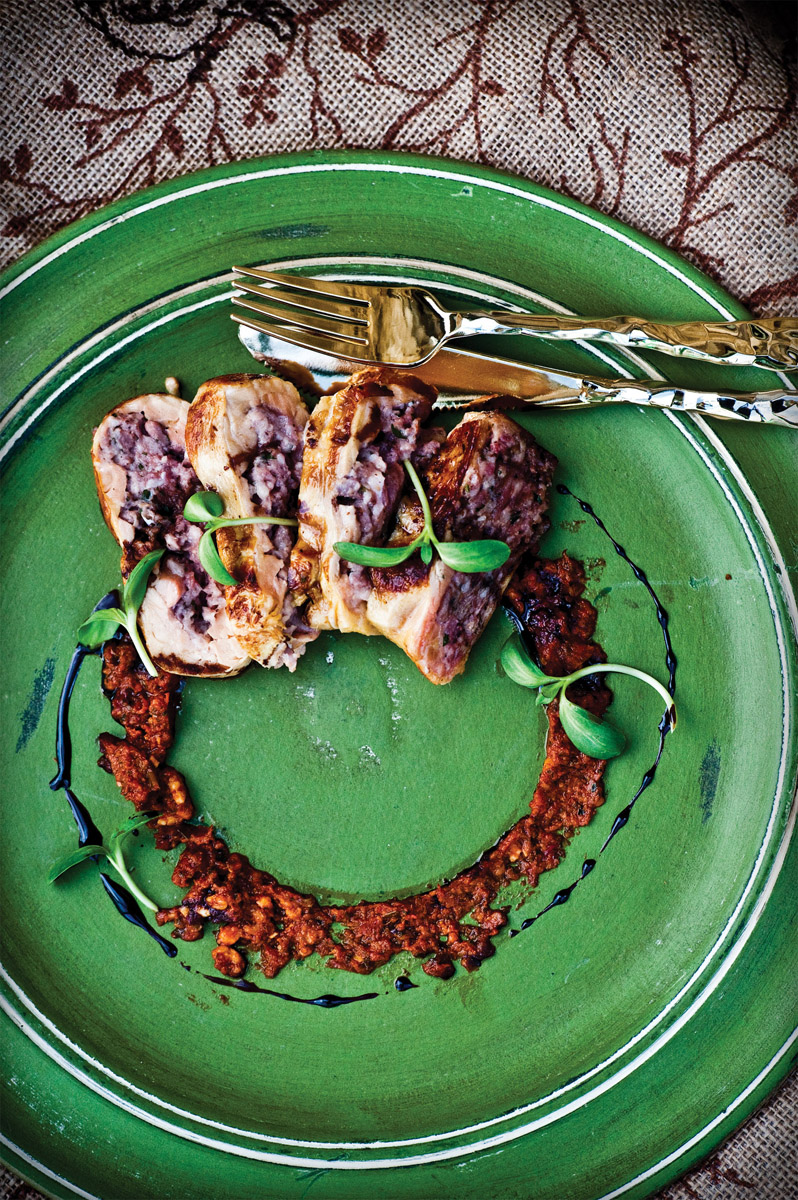
CHEF’S TIP
Poaching
The old-fashioned method of slow-cooking in liquid works best with a generous dose of patience. To ensure the desired tenderness, starting with cold water is essential. Allowing the poaching liquid to gradually reach barely a boil takes more time than most of us are accustomed to, but the extra minutes are the key to success here.
FOR THE POACHING LIQUID:
4–5 cups cold water
2 bay leaves
1 clove garlic
¼ teaspoon whole red peppercorns
Submerge ballotine in cold water in a medium-size pot. Season with bay leaves, garlic, and peppercorns. Over medium heat, bring the poaching liquid to a bare simmer (add patience here). Once it reaches that bare boil, turn to low heat and allow to poach for 20 minutes. Remove from liquid and prepare according to main recipe.
This is a bit of a challenging preparation, but worth the effort. Essentially, it is a new variation of an old gourmet preparation of forcemeat rolled inside the boneless form of a game hen with the skin intact. It entails using the remaining meat and fat scraps trimmed from the whole duck you presumably made recently (Duck Grand Marnier Two Ways, recipe page 121) and requires a meat grinder. If you are not yet daunted, then this is the culinary challenge for you.
SERVES 4
Ingredients
FOR THE CORNISH HENS:
2 Cornish game hens
8 ounces duck scrap, chilled (trimmed fat and meat from Duck Grand Marnier Two Ways, recipe page 121)
⅓ cup cremini mushrooms
1 tablespoon chopped shallot
⅛ teaspoon nutmeg
⅛ teaspoon juniper berries
½ teaspoon allspice
½ teaspoon kosher salt
FOR THE BALSAMIC FIG REDUCTION SAUCE:
½ cup diced dried figs
¼ cup granulated sugar
2 cups red wine
2 tablespoons balsamic vinegar
Instructions
TO PREPARE THE CORNISH HENS:
Starting on the hens’ backs, cut the flesh and skin away from the bones, being careful to keep the skin intact, discarding the wings and legs (reserve bones and legs for stock; see Chicken Stock recipe page 184). Wrap in plastic and refrigerate until ready to roll with the forcemeat.
Combine the duck trim with mushrooms, shallots, and spices in a food processor until thoroughly mixed, but still chunky rather than smooth. Chill forcemeat in the refrigerator for about an hour. Keeping the poultry and forcemeat chilled will make it easy to form into rolls. While the forcemeat chills, make the balsamic fig reduction sauce.
TO MAKE THE BALSAMIC FIG REDUCTION SAUCE:
Combine all ingredients in a saucepan. Bring to a boil, then reduce to a simmer. Simmer until sauce coats the back of a spoon. Reserve for dinner service. Sauce can be made a day ahead and keeps for up to 2 weeks in a sealed container at room temperature.
TO MAKE THE BALLOTINE:
Remove chilled hens and forcemeat from the refrigerator. Lay hens onto a flat surface, skin-side down. Divide the forcemeat equally between the hens and roll up into logs. Tie with butcher twine. Sous vide at 140°F for 1½ hours (See “Cooking Techniques” for details, page 196); alternatively, you can opt to poach the ballotine (see Chef’s Tip on previous page).
TO ASSEMBLE:
Heat a skillet with a small amount of oil. Place ballotines in the pan and sear all sides. To serve, slice the ballotine and arrange as a fan; finish with the balsamic fig reduction. This is great served over the Red Lentil Puree (recipe page 90).
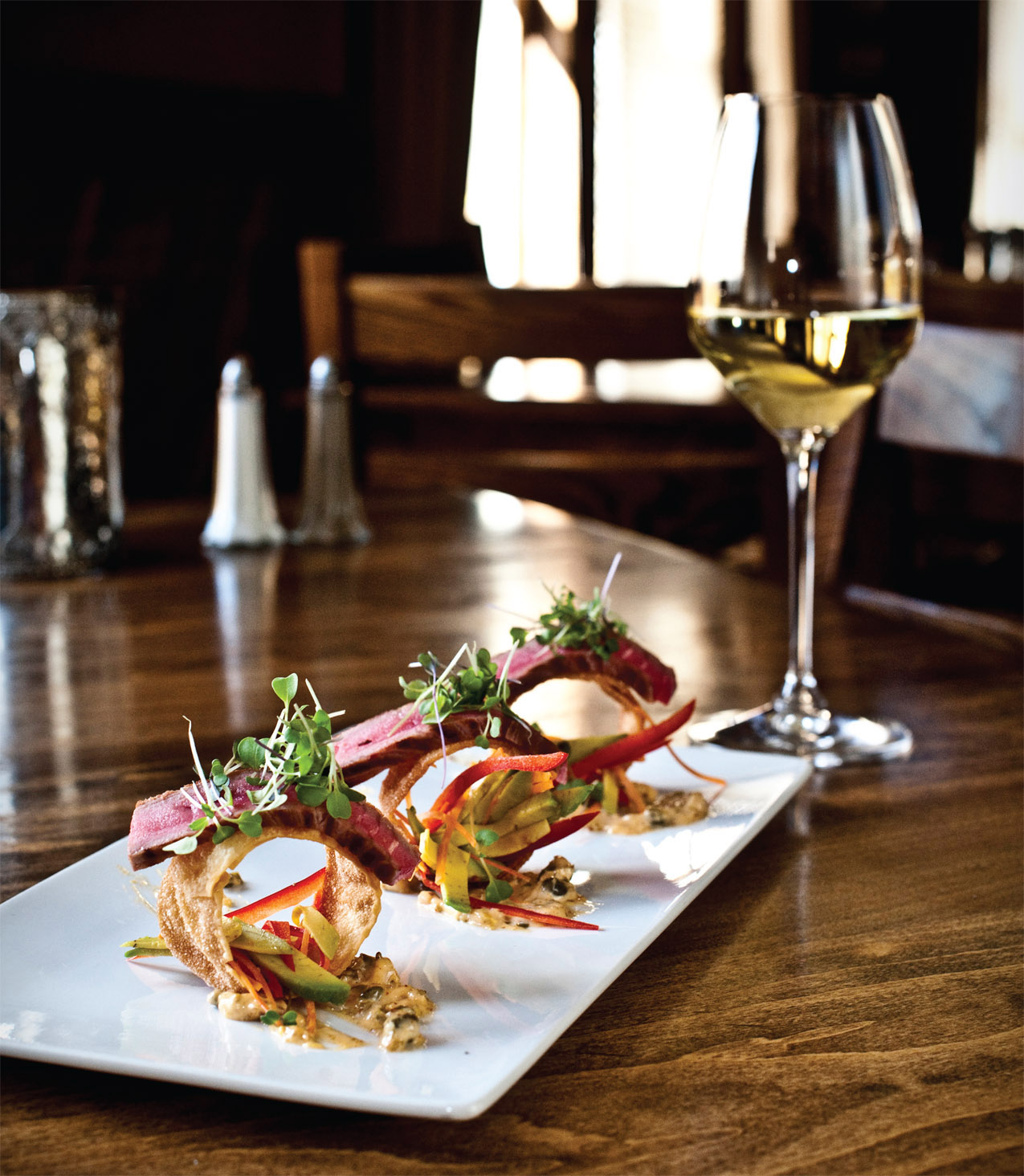
Celebrating the abundant access to the freshest ingredients, Chef Dave Wells brings an Asian flair to this appetizer. While the spiral of fried wonton makes actually eating the deconstructed wonton seem daunting, there is added pleasure in shattering its perfection to mix in the crunch with the velvety fresh ahi and avocado slaw with the first bite.
SERVES 8
Ingredients
FOR THE TUNA WONTONS:
1 package wonton wrappers
8 ounces sushi grade ahi
FOR THE CITRUS CHILI AIOLI:
2 egg yolks
2 cloves garlic
Juice of ½ lemon and ½ lime
1 cup canola oil
2 fresh jalapeños
1 tablespoon chopped cilantro
Zest of 1 lemon and 1 lime
Salt to taste
FOR THE AVOCADO SLAW:
2 scallions
¼ cup cilantro
1 red bell pepper
1 avocado, finely diced
⅛ teaspoon cumin
Juice of ½ lime
Salt to taste
Instructions
TO PREPARE THE WONTONS:
Cut wontons into strips. Moisten with water and wrap around a ring mold. Tie with butcher’s twine. Fry in a deep fryer at 350°F until golden brown. Take off twine and gently remove the wonton from the ring mold to reveal a delicate spiral. (For a simpler option, simply fry wonton strips in 2 inches of canola oil over medium-high heat in a large pan.)
TO PREPARE THE AIOLI:
In a food processor, combine egg yolks, garlic, and citrus juice. Run processor on high until the yolks are whipped and fluffy. Slowly drizzle in oil until emulsified. Seed the jalapeños and dice fine. Fold jalapeños into aioli with the cilantro and citrus zest. Salt to taste.
TO PREPARE THE AHI:
Heat a skillet with a couple of tablespoons of canola oil. Salt the ahi. When pan starts to smoke, add ahi and sear both sides, cooking the fish rare. Slice the fish into thin slices.
TO PREPARE THE SLAW:
Finely julienne the scallions, cilantro, and bell pepper. Combine with avocado, cumin, lime juice, and salt to taste.
TO ASSEMBLE:
Spoon a teaspoon of aioli on the plate and place a wonton vertically on the aioli. Spoon a little slaw into the round of the wonton and place a slice of ahi on top.

This is an uncommon combination of flavors. The salty, crunchy, and smooth texture of these three simple components creates a satisfying teaser at the start of a fine meal.
SERVES 6
Ingredients
1 tablespoon canola oil
6 quail eggs
6 asparagus tips
6 ounces nduja (a spicy, spreadable salumi; a chorizo spread [see below] can be substituted)
1 tablespoon olive oil
Salt to taste
Instructions
In a hot skillet that is lightly oiled with canola oil, fry the quail eggs sunny-side up. Slice the asparagus tips in half and toss with a little olive oil and salt. Roast at 400°F until tender, about 5 to 10 minutes.
Spread 1 ounce of nduja on the plate, stack two halves of asparagus, and top with a quail egg.
CHEF’S TIP
Note: If you can’t find nduja, you can replace it with the following:
7 ounces Spanish chorizo
2–3 tablespoons olive oil
Dice the chorizo and place in food processor. Process and add oil until the chorizo becomes a smooth paste.
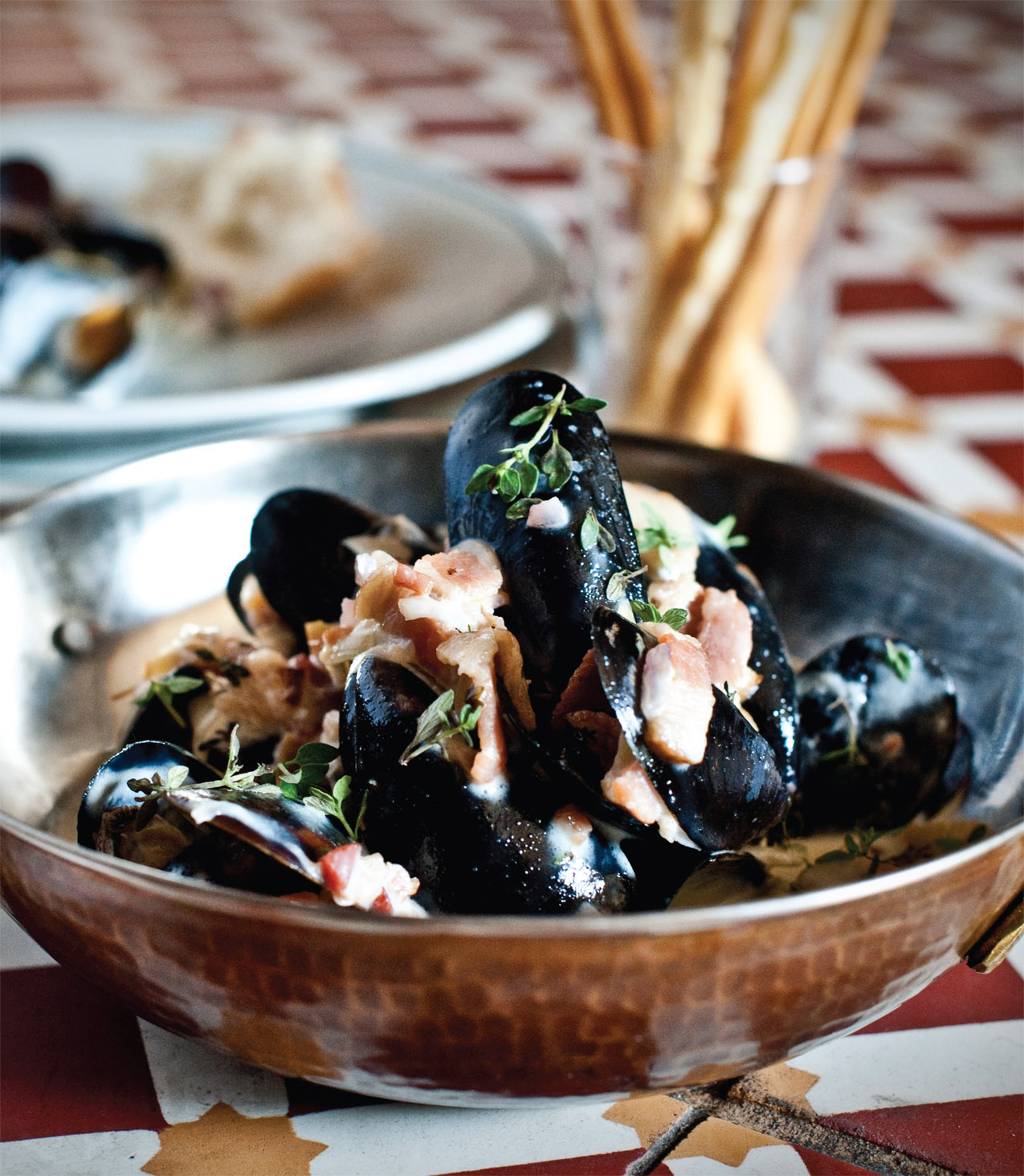
The preparation of freshly steamed mussels varies in the dining room each evening based on seasonal ingredients. A bright cream sauce never disappoints, and in this recipe the balance of cream with a hint of tanginess from the lemon and apple accompanies the rustic flavors of onion and bacon beautifully.
SERVES 6–8
Ingredients
½ cup diced bacon
1½ cups julienned yellow onion
2 Granny Smith apples, diced
2 pounds mussels
1 cup white wine
1 cup half-and-half
2 tablespoons lemon juice
1 tablespoon fresh thyme
Salt to taste
Instructions
Render the diced bacon in a large skillet over medium-high heat. Remove when crispy. Caramelize onions in the bacon fat. Add apples and sauté for a few minutes until slightly softened, then add bacon and mussels. Deglaze with wine, being sure to scrape up all the fond from the pan with a wooden spoon. Reduce by half. Add half-and-half and simmer for a few more minutes, then add lemon juice and thyme. Salt to taste.
Serve with crusty bread or Fennel Breadsticks (recipe page 41).

Chico started serving this timeless hors d’oeuvre in 1976. It was a delicacy in Montana at the time, since fresh seafood was not readily available. Fresh oysters were flown in once a week to Billings (about 200 miles away), and the owners would go pick up the order. Today, with fresh seafood flown into Bozeman regularly and delivered to Chico, it’s much easier to offer oysters on the menu.
SERVES 6
Ingredients
2 slices bacon, julienned
1 large yellow onion, diced
2 tablespoons minced garlic
2 cups fresh spinach, julienned
1 tablespoon anisette liqueur
¾ cup heavy whipping cream
2 dozen raw oysters on the half shell
¼ cup grated Parmesan cheese
2 cups coarse rock salt
¾ cup Hollandaise Sauce (recipe page 188)
Instructions
Preheat oven to 450°F. Render julienned bacon in a large sauté pan. Add onions and cook until translucent. Combine garlic, spinach, anisette, and cream; mix with bacon and onions. Cook until spinach is wilted. Remove from heat.
Place oysters on a baking sheet and spoon 1 heaping teaspoon of the spinach mixture onto each oyster, then sprinkle with Parmesan. Bake until spinach mixture browns on top, about 8 minutes. While the oysters are cooking, quickly prepare a platter with a bed of coarse salt. Remove oysters from the oven and gently place them onto the salt. Top each oyster with a dollop of hollandaise sauce, about ½ teaspoon and serve warm.